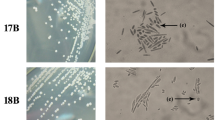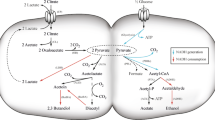Abstract
The whole-cell biocatalyst displaying Candida antarctica lipase B (CALB) on the yeast cell surface with α-agglutinin as the anchor protein was easy to handle and possessed high stability. The lyophilized CALB-displaying yeasts showed their original hydrolytic activity and were applied to an ester synthesis using ethanol and l-lactic acid as substrates. In water-saturated heptane, CALB-displaying yeasts catalyzed ethyl lactate synthesis. The synthesis efficiency increased depending on temperature and reached approximately 74% at 50°C. The amount of l-ethyl lactate increased gradually. l-Ethyl lactate synthesis stopped at 200 h and restarted after adding of l-lactic acid at 253 h. It indicated that CALB-displaying yeasts retained their synthetic activity under such reaction conditions. In addition, CALB-displaying yeasts were able to recognize l-lactic acid and d-lactic acid as substrates. l-Ethyl lactate was prepared from l-lactic acid and d-ethyl lactate was prepared from d-lactic acid using the same CALB-displaying whole-cell biocatalyst. These findings suggest that CALB-displaying yeasts can supply the enantiomeric lactic esters for preparation of useful and improved biopolymers of lactic acid.





Similar content being viewed by others
References
Anderson EM, Larsson KM, Kirk O (1998) One biocatalyst: many applications: the use of Candida antarctica B-lipase in organic synthesis. Biocatal Biotransform 16:181–204
De Boer JP, Teixeira de Mattos MJ, Neijssek OM (1990) D(−) Lactic acid production by suspended and aggregated continuous cultures of Bacillus laevolacticus. Appl Microbiol Biotechnol 34:149–153
Du W, Xu Y, Zeng J, Liu D (2004) Novozym 435-catalysed transesterification of crude soya bean oils for biodiesel production in a solvent-free medium. Biotechnol Appl Biochem 40:187–190
Foresti ML, Ferreira ML (2004) Computational approach to solvent-free synthesis of ethyl oleate using Candida rugosa and Candida antarctica B lipases. I. Interfacial activation and substrate (ethanol oleic acid) adsorption. Biomacromolecules 5:2366–2375
From M, Adlercreutz P, Mattiasson B (1997) Lipase catalyzed esterification of lactic acid. Biotechnol Lett 19:315–317
Garcia-Alles LF, Gotor V (1998) Alcohol inhibition and specificity studies of lipase B from Candida antarctica in organic solvents. Biotechnol Bioeng 59:163–170
Hasegawa S, Azuma M, Takahashi K (2008a) Enzymatic esterification of lactic acid, utilizing the basicity of particular polar organic solvents to suppress the acidity of lactic acid. J Chem Technol Biotechnol 83:1503–1510
Hasegawa S, Azuma M, Takahashi K (2008b) Stabilization of enzyme activity during the esterification of lactic acid in hydrophobic ethers and ketones as reaction media that are miscible with lactic acid despite their high hydrophobicity. Enzyme Microb Technol 43:309–316
Heriban V, Sturdik E, Zalibara L, Matus P (1993) Process and metabolic characteristics of Bacillus coagulans as a lactic acid producer. Lett Appl Microbiol 16:243–246
Hofvendahl K, Hägerdal BH (2000) Factors affecting the fermentative lactic acid production from renewable resources. Enzyme Microb Technol 26:87–107
Ikeda Y, Jamshidi K, Tsuji H, Hyon SH (1987) Stereocomplex formation between enantiomeric poly(lactides). Macromolecules 20:904–906
Jamshidi K, Hyon SH, Ikeda Y (1988) Thermal characterization of polylactides. Polymer 29:2229–2234
Kato M, Fuchimoto J, Tanino T, Kondo A, Fukuda H, Ueda M (2007) Preparation of a whole-cell biocatalyst of mutated Candida antarctica lipase B (mCALB) by a yeast molecular display system and its practical properties. Appl Microbiol Biotechnol 75:549–555
Kirk O, Christensen MW (2002) Lipase from Candida antarctica: unique biocatalysts from a unique origin. Org Process Res Dev 6:446–451
Larios A, Garcia HS, Oliart RM, Valerio-Alfaro G (2004) Synthesis of flavor and fragrance esters using Candida antarctica lipase. Appl Microbiol Biotechnol 65:373–376
McNeill IC, Leiper HA (1984) Degradation studies of some polyesters and polycarbonates-1. Polylactide: general features of the degradation under programmed heating conditions. Polym Degrad Stab 11:267–285
Mecking S (2004) Nature or petrochemistry?—biologically degradable materials. Angew Chem Int Ed 43:1078–1085
Nagahata R, Sugiyama J, Velmathi S, Nakao Y, Goto M, Takeuchi K (2004) Synthesis of poly(ethylene terephthalate-co-isophthalate) by copolymerization of ethylene isophthalate cyclic dimer and bis(2-hydroxyethyl) terephthalate. Polym J 36:483–488
Patkar S, Bjorkling F, Zundell M, Schulein M, Svendsen A, Heldt-Hansen HP, Gormsen E (1993) Purification of two lipases from Candida antarctica and their inhibition by various inhibitors. Indian J Chem 32B:76–80
Richard A, Kalra GB (2002) Biodegradable polymers for the environment. Science 297:803–807
Shiraga S, Kawakami M, Ishiguro M, Ueda M (2005) Enhanced reactivity of Rhizopus oryzae lipase displayed on yeast cell surfaces in organic solvents: potential as a whole-cell biocatalyst in organic solvents. Appl Environ Microbiol 71:4335–4338
Södergård A, Näsman JH (1994) Stabilization of poly(l-lactide) in the melt. Polym Degrad Stab 46:25–30
Tajima M, Nogi Y, Fukasawa T (1985) Primary structure of the Saccharomyces cerevisiae GAL7 gene. Yeast 1:67–77
Tanino T, Ohno T, Aoki T, Fukuda H, Kondo A (2007) Development of yeast cells displayed Candida antarctica lipase B and their application to ester synthesis reaction. Appl Microbiol Biotechnol 75:1319–1325
Tanino T, Aoki T, Chung WY, Watanabe Y, Ogino C, Fukuda H, Kondo A (2009) Improvement of a Candida antarctica lipase B-displaying yeast whole-cell biocatalyst and its application to the polyester synthesis reaction. Appl Microbiol Biotechnol 82:59–66
Tsuji H (2000) In vitro hydrolysis of blends from enantiomeric poly(lactide)s. Part 1. Well-stereo-complexed blend and non-blended films. Polymer 41:3621–3630
Tsuji H (2003) In vitro hydrolysis of blends from enantiomeric poly(lactide)s. Part 4. Well-stereo-complexed blend and non-blended films. Biomaterials 24:537–547
Tsuji H, Fukui I (2003) Enhanced thermal stability of poly(lactide)s in the melt by enantiomeric polymer blending. Polymer 44:2891–2896
Tsuji H, Ikeda Y (1999) Stereocomplex formation between enantiomeric poly(lactic acid)s. XI. Mechanical properties and morphology of solution-cast films. Polymer 40:6699–6708
Ueda M, Tanaka A (2000) Genetic immobilization of proteins on the yeast cell surface. Biotechnol Adv 18:121–140
Wachsen O, Platkowski K, Reichert KH (1996) Thermal degradation of poly-l-lactide—studies on kinetics, modeling and melt stabilization. Polym Degrad Stab 57:87–94
Zaks A, Klibanov AM (1988) Enzymatic catalysis in nonaqueous solvents. J Biol Chem 263:3194–3201
Zhang N, Suen WC, Windsor W, Xiao L, Madison V, Zaks A (2003) Improving tolerance of Candida antarctica lipase B towards irreversible thermal inactivation through directed evolution. Protein Eng 16:599–605
Author information
Authors and Affiliations
Corresponding author
Rights and permissions
About this article
Cite this article
Inaba, C., Maekawa, K., Morisaka, H. et al. Efficient synthesis of enantiomeric ethyl lactate by Candida antarctica lipase B (CALB)-displaying yeasts. Appl Microbiol Biotechnol 83, 859–864 (2009). https://doi.org/10.1007/s00253-009-1931-x
Received:
Revised:
Accepted:
Published:
Issue Date:
DOI: https://doi.org/10.1007/s00253-009-1931-x




